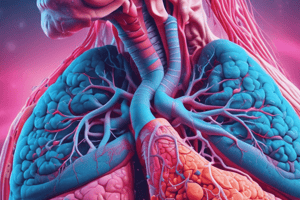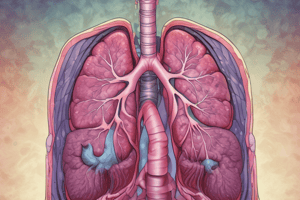Podcast
Questions and Answers
A patient with a suspected lung abscess exhibits increased tactile fremitus and crackles. Which additional chest assessment finding would most strongly support the diagnosis of a lung abscess?
A patient with a suspected lung abscess exhibits increased tactile fremitus and crackles. Which additional chest assessment finding would most strongly support the diagnosis of a lung abscess?
- Hyperresonant percussion note throughout the affected lung field.
- Decreased tactile fremitus.
- Distant breath sounds with absent whispered pectoriloquy.
- Dull percussion note over the affected area. (correct)
A patient with a severe lung abscess is likely to exhibit which of the following arterial blood gas (ABG) abnormalities?
A patient with a severe lung abscess is likely to exhibit which of the following arterial blood gas (ABG) abnormalities?
- Chronic ventilatory failure with hypoxemia.
- Compensated metabolic acidosis.
- Acute ventilatory failure. (correct)
- Acute alveolar hyperventilation with hyperoxemia.
Which of the following sets of oxygenation indices would most likely be observed in a patient with a significant lung abscess?
Which of the following sets of oxygenation indices would most likely be observed in a patient with a significant lung abscess?
- Decreased shunt, decreased O2 ER, increased diffusion, increased SvO2.
- Increased shunt, increased O2 ER, decreased diffusion, decreased SvO2. (correct)
- Normal shunt, normal O2 ER, normal diffusion, normal SvO2.
- Normal shunt, decreased O2 ER, increased diffusion, normal SvO2.
A chest radiograph of a patient with a suspected lung abscess is reviewed. Which of the following radiographic findings would be most indicative of a lung abscess?
A chest radiograph of a patient with a suspected lung abscess is reviewed. Which of the following radiographic findings would be most indicative of a lung abscess?
What is the MOST important component of the initial management plan for a patient diagnosed with a lung abscess?
What is the MOST important component of the initial management plan for a patient diagnosed with a lung abscess?
A patient with a lung abscess is likely to exhibit which primary pathological change within the affected lung tissue?
A patient with a lung abscess is likely to exhibit which primary pathological change within the affected lung tissue?
What is the most common initial cause of a lung abscess?
What is the most common initial cause of a lung abscess?
Which of the following conditions is least likely to predispose a patient to develop a lung abscess due to aspiration?
Which of the following conditions is least likely to predispose a patient to develop a lung abscess due to aspiration?
A patient with a lung abscess suddenly coughs up a large amount of foul-smelling, brown sputum. What is the most likely explanation for this?
A patient with a lung abscess suddenly coughs up a large amount of foul-smelling, brown sputum. What is the most likely explanation for this?
A patient with a history of alcohol abuse is diagnosed with a lung abscess. Which location in the lungs is the abscess most likely to be found?
A patient with a history of alcohol abuse is diagnosed with a lung abscess. Which location in the lungs is the abscess most likely to be found?
What is the likely cause of an increased respiratory rate in a patient with a lung abscess?
What is the likely cause of an increased respiratory rate in a patient with a lung abscess?
If a lung abscess develops due to vascular obstruction, what is the likely cause of this obstruction?
If a lung abscess develops due to vascular obstruction, what is the likely cause of this obstruction?
What is the significance of poor oral hygiene in the etiology of lung abscesses?
What is the significance of poor oral hygiene in the etiology of lung abscesses?
Flashcards
Lung Abscess
Lung Abscess
Necrosis of lung tissue leading to a cavity.
Alveolar Consolidation
Alveolar Consolidation
A process where alveoli fill with fluid or solid material.
Etiology of Lung Abscess
Etiology of Lung Abscess
Commonly caused by aspiration and infections from multiple organisms.
Foul-smelling Sputum
Foul-smelling Sputum
Signup and view all the flashcards
Increased Respiratory Rate
Increased Respiratory Rate
Signup and view all the flashcards
Predisposing Factors
Predisposing Factors
Signup and view all the flashcards
Cavity Formation
Cavity Formation
Signup and view all the flashcards
Physical Exam Signs
Physical Exam Signs
Signup and view all the flashcards
Chest Assessment Findings
Chest Assessment Findings
Signup and view all the flashcards
PFT Data
PFT Data
Signup and view all the flashcards
ABG Results
ABG Results
Signup and view all the flashcards
Sputum Characteristics
Sputum Characteristics
Signup and view all the flashcards
Management Protocol
Management Protocol
Signup and view all the flashcards
Study Notes
Lung Abscess
- Lung abscess is a localized collection of pus in the lung tissue.
- Early presentation of a lung abscess can mimic pneumonia.
- Necrosis of lung tissue is a key feature.
- Neutrophils and macrophages migrate to the affected area.
- Alveoli become consolidated, potentially forming a localized air/fluid-filled cavity.
- The fluid in the cavity is a purulent exudate, consisting of liquefied white blood cells, proteins, and tissue debris.
Anatomical Alterations
- Main pathology: Alveolar consolidation, alveolar/bronchial wall destruction, tissue necrosis with cavity formation, fibrosis and calcification of lung tissue, bronchopleural fistula, and empyema, atelectasis and excessive airway secretions.
Etiology
- Most common causes: Aspiration of bacteria (e.g., Klebsiella, Staphylococcus), anaerobic organisms. Poor oral hygiene can contribute to anaerobic organisms.
- Predisposing factors for aspiration: Alcohol abuse, seizure disorders, head trauma, swallowing disorders, general anesthesia, and cerebrovascular accidents (CVAs).
- Other causes: Infections of more than one organism, bronchial obstruction, cavitating infections (may originate distally from cancer or foreign objects), vascular obstructions, septic embolisms, infected lung cysts/bullae, infected penetrating chest wounds.
Etiology (Location)
- Commonly found in the lower lobes, and posterior segments of the upper lobes.
- Aspiration often results in abscesses in the dependent portion of the lung (right lung more than left due to gravity).
Clinical Data (Physical Exam)
- Increased respiratory rate.
- Hypoxemia (low blood oxygen) stimulates the peripheral chemoreceptors, further increasing respiration.
- Hypoxia can decrease blood pressure as the body tries to get more (O2 rich) blood.
- Pain, anxiety, and fever are common symptoms.
- Stimulation of J receptors also plays a role in increasing respiratory rate.
Clinical Data (Inflammatory Stage)
- Cough (initial stage often non-productive; later stages can be vigorous).
- Abscesses can rupture into a cavity and cause the production of foul-smelling brown/gray sputum.
Clinical Data (Further)
- Increased heart rate, blood pressure, and cardiac output due to hypoxia.
- Chest pain and decreased chest excursion.
- Cyanosis (bluish discoloration of the skin).
- Cough and sputum production.
- Cavity rupture into bronchus may lead to foul-smelling sputum of brown/gray or greenish/yellow color (may be blood-streaked).
- Chest assessment often reveals increased tactile and vocal fremitus, crackles, and rhonchi.
- Percussion note over the abscess may be dull, and bronchial breath sounds and diminished breath sounds may be noted.
- Whispering pectoriloquy and pleural friction rub may also be present.
Clinical Data (PFT and ABG)
- PFTs: Reduced lung volumes, usually normal airflow.
- ABGs: Acute alveolar hyperventilation with hypoxemia (mild to moderate abscess), and acute ventilatory failure (severe abscess). Oxygenation indices show increased shunt, increased O2 demand, reduced diffusion, and reduced SvO2. Normal oxygen consumption and blood oxygen content are often maintained.
Clinical Data (Other)
- Sputum analysis may reveal gram-positive and anaerobic organisms.
- Radiological findings often show increased opacity and cavity formation, and sometimes air-fluid levels, pleural effusion, and fibrosis. Consolidation (localized areas of solid lung tissue) may be evident early in the process.
Management
- Medications: Antibiotics based on culture and sensitivity testing.
- Interventions: Oxygen as needed determined by patient's protocol, and bronchial hygiene to remove mucus, and surgery for drainage.
- Bronchoscopy may also be indicated.
- Hyperinflation therapy protocol.
Studying That Suits You
Use AI to generate personalized quizzes and flashcards to suit your learning preferences.




